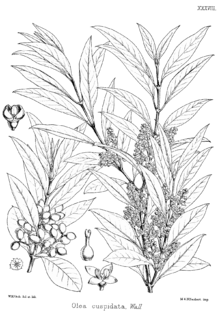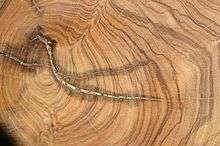Olea europaea subsp. cuspidata
| Wild olive | |
|---|---|
 | |
| Scientific classification | |
| Kingdom: | Plantae |
| (unranked): | Angiosperms |
| (unranked): | Eudicots |
| (unranked): | Asterids |
| Order: | Lamiales |
| Family: | Oleaceae |
| Genus: | Olea |
| Species: | O. europaea |
| Subspecies: | O. europaea subsp. cuspidata |
| Trinomial name | |
| Olea europaea subsp. cuspidata (Wall. ex G. Don) Cif. | |
| Synonyms[1] | |
| |
Olea europaea subsp. cuspidata (syn. Olea chrysophylla[2]) is a subspecies of olive previously described as Olea cuspidata and Olea africana. It has various common names, including African olive,[3] wild olive,[3] iron tree, brown olive,[3] and Indian olive.[3]
Description
This much-branched evergreen tree varies in size from 2 to 15 m high. The leaves have an opposite, decussate arrangement, and are entire, 3 to 7 cm long and 0.8 to 2.5 cm wide; the apex is acute with a small hook or point, and the base is attenuate to cuneate. Leaf margins are entire and recurved, the upper surface is grey-green and glossy, and the lower surface has a dense covering of silvery, golden or brown scales. Domatia are absent; venation is obvious on the upper surface and obscure on the lower surface; the petiole is up to 10 mm long.
Fruit are borne in panicles or racmes 50 to 60mm long. The calyx is four-lobed, about 1mm long. The corolla is greenish-white or cream; the tube is 1 to 2mm long; lobes are about 3mm long and reflexed at the anthesis. The two stamens are fused near the top of the corolla tube, with bilobed stigma.
The globose to ellipsoid fruit is a drupe, 6mm in diameter and 15 to 25 mm long; it is fleshy, glaucous to a dull shine when ripe, and purple-black. The tree usually flowers in spring.
The wood is much-prized and durable, with a strong smell similar to bay rum, and is used for fine furniture and turnery.

Distribution
An extensive native range from South Africa, through Africa, the Middle East, Pakistan, India to China. Subtropical dry forests of Olea europaea cuspidata are found in the Himalayan subtropical broadleaf forests ecoregion. In areas where it is not native, such as Australia, it is classified as a noxious weed. It is spread mainly by birds eating the fruit.
Pictures
-

A close-up of its foliage
-
A specimen growing in Cape Town
-
A young tree in its natural habitat in southern Africa
-

This subspecies of olive has been introduced to Hawaii.
| Wikimedia Commons has media related to Olea europaea subsp. cuspidata. |
References
- ↑ "The Plant List: A Working List of All Plant Species". Retrieved June 27, 2014.
- ↑ http://www.theplantlist.org/tpl1.1/record/kew-355032
- 1 2 3 4 "USDA GRIN entry for Olea europaea subsp. cuspidata". Retrieved 27 June 2014.